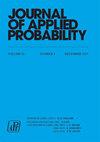Uncertainty quantification and confidence intervals for naive rare-event estimators
IF 0.7
4区 数学
Q3 STATISTICS & PROBABILITY
引用次数: 0
Abstract
We consider the estimation of rare-event probabilities using sample proportions output by naive Monte Carlo or collected data. Unlike using variance reduction techniques, this naive estimator does not have an a priori relative efficiency guarantee. On the other hand, due to the recent surge of sophisticated rare-event problems arising in safety evaluations of intelligent systems, efficiency-guaranteed variance reduction may face implementation challenges which, coupled with the availability of computation or data collection power, motivate the use of such a naive estimator. In this paper we study the uncertainty quantification, namely the construction, coverage validity, and tightness of confidence intervals, for rare-event probabilities using only sample proportions. In addition to the known normality, Wilson, and exact intervals, we investigate and compare them with two new intervals derived from Chernoff’s inequality and the Berry–Esseen theorem. Moreover, we generalize our results to the natural situation where sampling stops by reaching a target number of rare-event hits. Our findings show that the normality and Wilson intervals are not always valid, but they are close to the newly developed valid intervals in terms of half-width. In contrast, the exact interval is conservative, but safely guarantees the attainment of the nominal confidence level. Our new intervals, while being more conservative than the exact interval, provide useful insights into understanding the tightness of the considered intervals.天真罕见事件估计器的不确定性量化和置信区间
我们考虑使用蒙特卡洛模拟或收集的数据输出的样本比例来估计罕见事件概率。与使用方差缩小技术不同的是,这种天真的估计方法没有先验的相对效率保证。另一方面,由于最近在智能系统安全评估中出现了大量复杂的罕见事件问题,有效率保证的方差缩小可能面临实施上的挑战,再加上计算或数据收集能力的可用性,促使我们使用这种天真估计器。在本文中,我们仅使用样本比例来研究罕见事件概率的不确定性量化,即置信区间的构建、覆盖有效性和紧密性。除了已知的正态性区间、威尔逊区间和精确区间外,我们还研究并比较了从切尔诺夫不等式和贝里-埃森定理推导出的两个新区间。此外,我们还将结果推广到自然情况下,即在达到目标罕见事件命中数时停止采样。我们的研究结果表明,正态区间和威尔逊区间并不总是有效的,但就半宽度而言,它们接近于新开发的有效区间。相比之下,精确区间比较保守,但能安全地保证达到名义置信水平。我们的新区间虽然比精确区间更保守,但为理解所考虑区间的紧密性提供了有用的见解。
本文章由计算机程序翻译,如有差异,请以英文原文为准。
求助全文
约1分钟内获得全文
求助全文
来源期刊

Journal of Applied Probability
数学-统计学与概率论
CiteScore
1.50
自引率
10.00%
发文量
92
审稿时长
6-12 weeks
期刊介绍:
Journal of Applied Probability is the oldest journal devoted to the publication of research in the field of applied probability. It is an international journal published by the Applied Probability Trust, and it serves as a companion publication to the Advances in Applied Probability. Its wide audience includes leading researchers across the entire spectrum of applied probability, including biosciences applications, operations research, telecommunications, computer science, engineering, epidemiology, financial mathematics, the physical and social sciences, and any field where stochastic modeling is used.
A submission to Applied Probability represents a submission that may, at the Editor-in-Chief’s discretion, appear in either the Journal of Applied Probability or the Advances in Applied Probability. Typically, shorter papers appear in the Journal, with longer contributions appearing in the Advances.
 求助内容:
求助内容: 应助结果提醒方式:
应助结果提醒方式:


